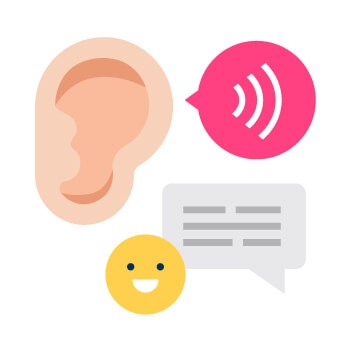What is Soft Selling and How to Leverage It In Sales

Contents
When you’re trying to hit your sales target, it’s easy to become a bit too… passionate in sales meetings. Sometimes this can come across as aggressive and actually put the buyer off.
Hubspot asked buyers to submit the word they most associated with salespeople. The number one response? Pushy. Ouch.
Want to avoid coming across as a pushy sales rep and deter prospects before you’ve even begun to build your relationship?
It’s time to learn the art of soft selling – which involves essentially turning the tables on most of your deeply ingrained sales instincts.
What is Soft Selling?
Soft selling is a sales approach that creates a more low-pressure sales experience for a prospect.
How?
This technique focuses more on subtle persuasion and casual, friendly language. The tone here should be conversational, keeping prospects engaged. It’s out with aggressive chasing and ultimatums, and in with friendly persuasion.
That said, soft selling shouldn’t be passive. No one wants to see their sales figures fall, and passive selling is a recipe for just that. Soft selling still involves trying to sell – it just approaches sales in a different way.
Sales reps that use a soft-sell approach can still be persistent throughout the process. In bullish days gone by, sales reps may have pulled out every technique in their arsenal to make the sale. Now, it’s about letting your product or service do the talking.
Hard sell vs soft sell
A traditional hard sell approach tends to look something like this:
Step 1: Acquire prospect’s contact details
Step 2: Call or email prospect to provide them with information about your product or service, and to arrange a sales meeting
Step 3: Attend sales meeting and close sale
Step 4: Where the sale was not closed in the meeting, email and call your contact several times per week to strongly encourage them to sign off on the sale
Step 5: Contact either decides to buy or doesn’t. Either way, this is the end of contact until product/service is due for renewal
Key tactics: Direct language, forward/pushy approach, focus on product/service you’re selling, mission is to sell as fast as possible, frequent contact until sale is closed
A soft sell approach tends to look something like this:
Step 1: Acquire prospect’s contact details through networking event, social media engagement, or inbound marketing
Step 2: Start to build relationship through emails, events, and social media engagement: find out about the prospect’s interests, hobbies, and job role
Step 3: Research the prospect’s company
Step 4: Arrange a casual call or meeting
Step 5: Spend call or meeting discussing prospect’s goals and challenges, and lay out how your product or service can address any obstacles to them meeting their goals
Step 6: Email over any information the prospect requested during the meeting or call, but give them space to make a decision
Step 7: Stay in contact with friendly – but not too-frequent – casual emails
Step 8: Close sale
Step 9: Continue to engage with them on social media and over email: there may be other opportunities within the company
Key tactics: Friendly language, selling at a pace that suits the prospect, focus on goals and challenges of company, mission is to inform, continue semi-regular contact once sale is made
How to Leverage Soft Selling
Rule one for relationship-building networking is this: Don’t dive straight into business with your new friend. Instead, foster a more relaxed, casual style of networking – one where the sale isn’t the foremost thing on your mind.
It’s simple. Find out how their day was, and chat about hobbies, interests or holidays. Even allow yourself to enjoy the conversation.
Later on, make a note of facts you’ve learned about them – a love of snowboarding or the New York Yankees, for example. This might sound a little creepy, but when it comes to relationship building, remembering tidbits from your previous conversations will go a long way towards creating a sense of continuity.
Referring back to these notes when following up proves you were listening and that you’re actually interested in them. This should trigger their memory of that conversation and – all being well – their positive sentiment towards you, and by extension, your organization.
This makes your post-event follow up email even easier to send. For example, you could try something like:
“Hi [prospect],
It was great to meet you at [event] earlier. Could we pencil in some time to chat more?”
Or you could get more personal with a message like this:
“Hi [prospect],
Great chatting with you earlier. Here’s that Yankees article I was telling you about earlier. Would love to continue our conversation – are you able to squeeze me in before you jet off to the Alps for your snowboarding trip?”
Don’t be overly aggressive with your personalization. We’ve all encountered salespeople who try to force personal details into every encounter in order to build rapport – whether or not it actually works.
Keep it natural. Think of how you’d address a friend who shared personal information with you and start from there.
Do Your Research
Soft selling is all about identifying a company’s challenges and working out how you and your product or service can help your prospect overcome them.
Extensive preparation would ideally be the status quo before every sales meeting – but we all know schedules don’t always allow for it. When it comes to soft selling, however, you’ve got to factor in plenty of research time ahead of your sales meeting.
Perform company and competitor research, and ask your prospect questions ahead of the first meeting. When you arrive, you can be confident that you understand the organization and its challenges, and that your product really is the solution they need.
Employ Active, Empathetic Listening
How many times have you been in a sales meeting, and drifted off thinking about what you’re going to say next while your prospect is still talking? We’ve pretty much all been guilty of it at some point.
Mastering the soft sell requires active listening. Listen to understand, nod, smile, and subtly mirror the speaker’s body language. Forget speaking over them, looking around the room, or checking your phone.
As well as listening attentively to what your prospect is saying, ensure you’re taking it in by repeating it back to them where appropriate, and asking for clarification when necessary.
Avoid autobiographical listening, too. This is where you listen, but through your own filter. It means you’re not really understanding what your contact is trying to get across, hindering your attempts to really help them.
Instead, try to employ empathetic listening, where you’re not just hearing what the speaker is saying, but putting yourself in their shoes and truly understanding the meaning they’re attempting to convey.
Provide Added Value from the Start
A big part of soft selling is demonstrating the added value your prospect will gain from both you and your product or service, should they go ahead with the sale – all without directly asking for the sale.
It can be tricky to put in extra work without knowing whether revenue will follow – and if your boss is old school, they might advise against it. But there are some workarounds you can use.
If you don’t have time to extensively research specific problems for each and every prospect you’re meeting, consider whether a lot of their needs are similar. For example, if you’re selling digital marketing solutions to companies that don’t have extensive marketing departments, a large part of your added value is going to come from the education you can provide on topics like SEO, backlinking strategies, or influencer marketing.
Alternatively, if your organization sells workflow management software, you’re likely to come up against a lot of technical and implementation questions – and prospects are going to want cold, hard proof that it improves efficiency.
Ask your marketing team to create written and video materials that cover relevant topics, answer common questions, and address challenges typical to your customer base in an accessible way.
This way, the digital marketing sales rep can send links to educational videos and copy on whichever topic their prospect has asked about. Meanwhile, the workflow management software sales team is able to provide prospects with testimonials, success stats, and tips on successfully rolling out new employee-facing software.
We all know personalization is everything these days. So for extra points, leave space in these materials for personalized content. This will make it possible for you to spend ten minutes personalizing content for each prospect, rather than ten hours creating bespoke packages for each of them.
Give Your Prospects Space
Soft selling is all about avoiding that “pushy salesperson” vibe – and this includes when you’re closing. It goes without saying that this part of the soft selling process is the most challenging to maintain and execute.
Once your prospect has all the information they need to decide whether to purchase, simply back off. I know, it sounds insane. In fact, backing off at this delicate stage of the sales cycle might go against all your sales instincts, but your prospect will thank you for it
“Backing off” doesn’t mean you can’t email your contact or call them to find out if they’re closer to making a decision, by the way. It does mean you should avoid doing this every day, or putting time pressure on your prospects to reach a decision.
Be Friendly 
In the cutthroat world of corporate sales, walking into a room filled with important execs can feel a little unfriendly. If you’re using soft selling, it’s your job to warm that frosty room up.
Approach your prospects with a friendly – but never unprofessional – attitude that lends itself to relationship building. Try to come across as very capable, but also endlessly approachable.
One easy avenue for doing so is to ask plenty of questions about the business, in order to show that you’re genuinely interested in helping it succeed.
Think about it like a first date. Your prospects will love talking about themselves and their organization. This is a double win, since your prospects spilling reams of information is only going to help you to get to know them, and (hopefully) to close the deal.
Finally, ensure your friendly tone carries over into all of your email and phone conversations. For soft selling to work its magic, the customer experience needs to be both consistent and empowering.





